-
Colonel
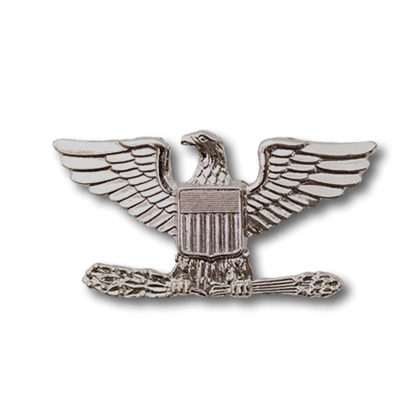 O6 | COL
O6 | COLDescription
The Colonel has one job only, to Command the Brigade. His is the final word on all things. His responsibility is all encompassing and all consuming. In short, he signs the checks.
Prerequisites
1. Appointed as Brigade Commander.
-
Lieutenant Colonel
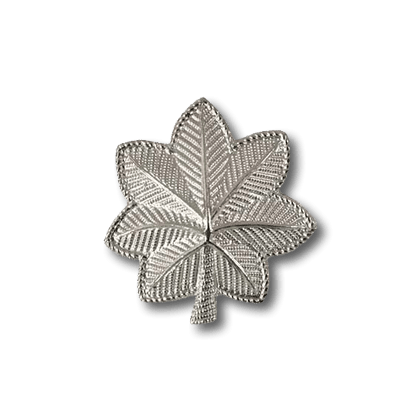 O5 | LTC
O5 | LTCDescription
The primary function of Lieutenant Colonels is to serve as commanders of battalion-sized elements. Although, they can also serve as staff officers at the brigade level or above, aiding in the planning, resourcing, and functioning of units.
Lieutenant Colonels generally serve as commanders of battalions and are the final authority on everything that occurs in that battalion, recognized as responsible for everything the battalion does or fails to do.
Prerequisites
1. Six (6) months TIG as O-4 Major
2. Appointed as Brigade Executive Officer or Battalion Commander
3. Personally promoted by the Commanding Officer of the Regiment
-
Major
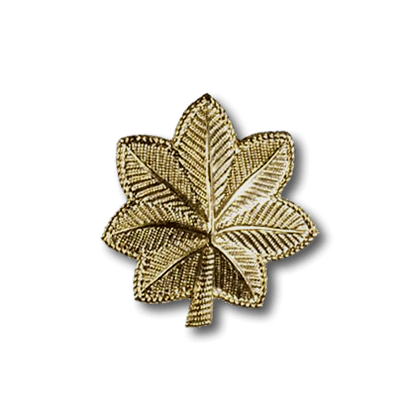 O4 | MAJ
O4 | MAJDescription
The Major is a Field Grade officer, one who is proven at all levels and can now be trusted with responsibilities that span the whole Regiment. The Major can serve as the Battalion Commander, Battalion Executive Officer, Brigade Staff Officer, or even Brigade Executive Officer. All eyes are on the Major, for he assists the leadership of the Division in all areas.
Prerequisites
1) Demonstrated excellence as a Commissioned Officer in all areas
2) Personally promoted by the Commanding Officer of the Regiment
-
Captain
 O3 | CPT
O3 | CPTDescription
To be promoted to Captain is to be the standard of excellence as a Company Commander and an Officer. The Captain enjoys universal respect from his Soldiers and fellow Officers and has made the Division a better place because his Company has been made ever stronger
Prerequisites
1) Demonstrated excellence as a Company Commander
2) Trusted member of Command Staff
3) Approval of the Commanding Officer of the Regiment -
First Lieutenant
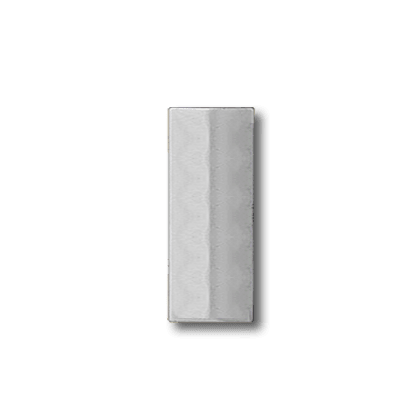 O2 | 1LT
O2 | 1LTDescription
The First Lieutenant has proven him/herself as a competent Platoon Leader and a trusted part of Command Staff. He has earned the confidence of his Soldiers and continues to improve his Platoon, Company and the Division as a whole.Prerequisites
1) Demonstrated excellence as a Platoon Leader or Aviation Detachment Commander, including Prerequisites of all ranks below E-7
2) Three (3) months to Six (6) months TIG at O-1 Second Lieutenant
3) Approval of the Commanding Officer of the Regiment -
Second Lieutenant
 O1 | 2LT
O1 | 2LTDescription
As the PV2 is the junior Soldiers and the CPL is the junior NCO, the Second Lieutenant is a junior Commissioned Officer, learning what it means to no longer wear stripes. Second Lieutenants are freshly minted Platoon Leaders, and do well to take heed the advice of the First Sergeant and also their Platoon Sergeant. They also have a seat at the table of Command Staff, but also do well to listen more than speak.
Prerequisites
1) Demonstrated excellence as a Soldier, NCO or Senior NCO, including Prerequisites of all ranks below E-7
2) Selection for OCS or Field Commission Board and successful passing
3) Approval of the Commanding Officer of the Regiment
-
Officer Candidate
 E5 | OCS
E5 | OCSDescription
Candidate School (OCS) is the U.S. Army's main training academy for prospective Army Officers. The school is generally open to qualified enlisted non-commissioned officers. Candidates who successfully complete the rigorous, 1 to 3 months school receive formal commissions as U.S. Army Officers and assume the ability to command Soldiers.
Prerequisites
1) Selected for Officer Candidate School (must be E-5 or higher for selection). -
Chief Warrant Officer 5
 W5 | CW5
W5 | CW5Description
Master-level technical and tactical experts that support brigade, division, corps, echelons above corps, and major command operations. They provide leader development, mentorship, advice, and counsel to WOs and branch officers. CW5s have special WO leadership and representation responsibilities within their respective commands.
Prerequisites
- Six (6) Months TIG as W-4 Chief Warrant Officer 4
- Selected as Detachment Commander or Detachment Command Chief Warrant Officer
- Approval from Battalion Leadership
-
Chief Warrant Officer 4
 W4 | CW4
W4 | CW4Description
Senior-level experts in their chosen field. They primarily support battalion, brigade, division, corps, and echelons above corps operations. CW4s typically have special mentorship responsibilities for other WOs and provide essential advice to commanders on WO issues.
Prerequisites
- Six (6) Months TIG as W-3 Chief Warrant Officer 3
- Selected as Detachment Command Chief Warrant Officer, Section Commander or Specialist Billet
- Successfully graduated from Warrant Officer Advanced Course (WOAC)
- Consistently delivers outstanding contributions to Flight and DMOS activities.
- A written recommendation from the Soldier’s 1st line leader
- A 1000 word essay on why the Soldier should be promoted to the next grade and what can the Soldier bring to better 3CAD as a whole
- Maintain an up to date personnel file uniform
- Approval from Company Leadership
-
Chief Warrant Officer 3
 W3 | CW3
W3 | CW3Description
Advanced-level experts who perform the primary duties that of a technical and tactical leader. They provide direction, guidance, resources, assistance, and supervision necessary for subordinates to perform their duties. CW3s primarily support operations levels from team or detachment through brigade.
Prerequisites
- Six (6) Months TIG as W-2 Chief Warrant Officer 2
- Selected as Detachment Command Chief Warrant Officer, Section Commander, Flight Leader or Specialist Billet
- Successfully graduated from Warrant Officer Basic Course (WOBC)
- Contributes greatly in Flight and DMOS activities
- A written recommendation from the Soldier’s 1st line leader
- A 750 word essay on why the Soldier should be promoted to the next grade and what can the Soldier bring to better 3CAD as a whole
- Maintain an up to date personnel file uniform
- Approval from Company Leadership
-
Chief Warrant Officer 2
 W2 | CW2
W2 | CW2Description
Chief Warrant Officers become commissioned officers by warrant as determined by the President of the United States. Chief Warrant Officers are intermediate level technical and tactical experts who perform increased duties and responsibilities at the detachment through battalion levels.
Prerequisites
- Six (6) Months TIG as W-1 Warrant Officer 1
- Contributes in Flight and participate in DMOS activities
- A written recommendation from the Soldier’s 1st line leader
- A 500 word essay on why the Soldier should be promoted to the next grade and what can the Soldier bring to better 3CAD as a whole
- Maintain an up to date personnel file uniform
-
Warrant Officer 1
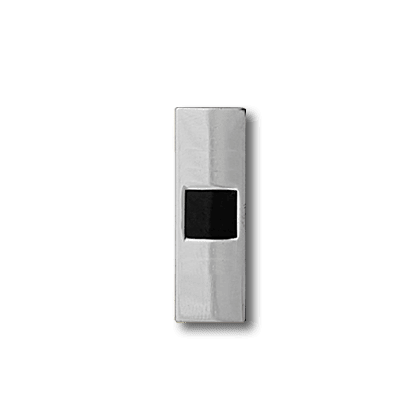 W1 | WO1
W1 | WO1Description
Appointed by warrant from the Secretary of the Army, Warrant Officer 1's are technically and tactically focused officers who perform the primary duties of technical leader, trainer, operator, manager, maintainer, sustainer, and adviser.
Prerequisites
- Graduation from Warrant Officer Candidate School
- No significant lapse in activity levels
-
Warrant Officer Candidate
 E5 | WOC
E5 | WOCDescription
Aviation Center of Excellence (Aviation School) is the U.S. Army's main training academy for prospective Warrant Officers. The school is generally open to qualified enlisted personnel. Candidates who successfully complete the rigorous training curriculum receive formal commissions as U.S. Army Warrant Officers.
Prerequisites
- Achieved rank of E-4B Specialist or waivered by Detachment Commander
- Minimum three months in an active billet
- Written recommendation from a Chief Warrant Officer 2 or higher
- Pass Selection Instrument for Flight Training (SIFT) with a minimum score of 50% (One retest available if the first test is failed.)
- Pass an Aviation Selection Board
- Willing to complete a 5 week Warrant Officer Candidate School
-
Command Sergeant Major
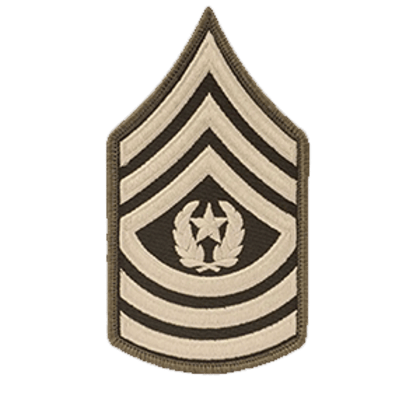 E9 | CSM
E9 | CSMDescription
The Command Sergeant Major is the commanding senior NCO of a color-bearing Army unit (battalion or higher). With a background of excellence in all areas of leadership including Company First Sergeant, the Command Sergeant Major represents the height of accomplishment in the NCO Corps. The Command Sergeant Major is a beast of his/her own and not to be trifle with.
Prerequisites
1) Special appointment by the Battalion Commander
-
Sergeant Major
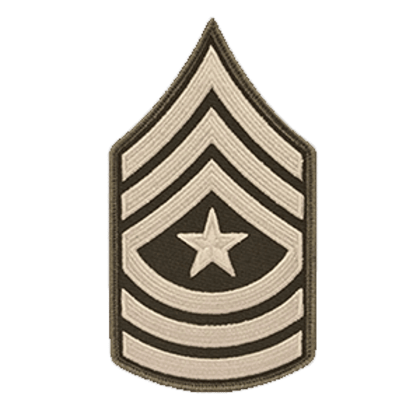 E9 | SGM
E9 | SGMDescription
The Sergeant Major is the principal Senior NCO of the Battalion. With a background of excellence in all areas of leadership including Company First Sergeant, the Sergeant Major represents the height of accomplishment in the NCO Corps. The Sergeant Major can move mountains, part the skies and place his boot where he wishes.
Prerequisites
1) Special appointment by the Battalion Commander
-
First Sergeant
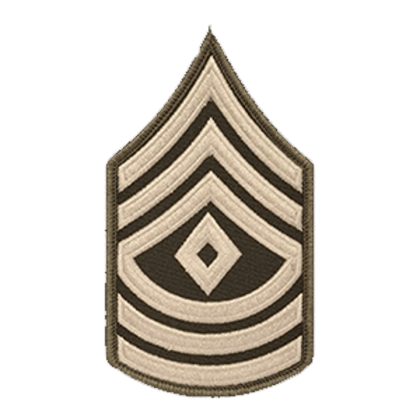 E8 | 1SG
E8 | 1SGDescription
When you are talking about the First Sergeant you are talking about the lifeblood of a Company. There can be no substitute of this position nor any question of its importance. When First Sergeants are exceptional, their units are exceptional, regardless of any other single personality involved. Perhaps their rank insignia should be the keystone rather than the traditional diamond. It is the First Sergeant at whom almost all unit operations merge. The First Sergeant is responsible for the welfare, discipline and training of all the Company's enlisted Soldiers and oversees most of the Company administrative, logistical and maintenance matters along with the XO.
Prerequisites
1) One (1) year TIS
2) Ability to assist the Company Commander or serve in his absence
3) Ability to write Company Reports in lieu of the Company Commander
4) Ability to actively participate in Command Staff activities and forums
5) Sets the standard of excellence in leadership throughout the Regiment
6) Demonstrated reputation of success as a Squad Leader and/or Platoon Sergeant
7) Recommendation from the Battalion Commander
-
Master Sergeant
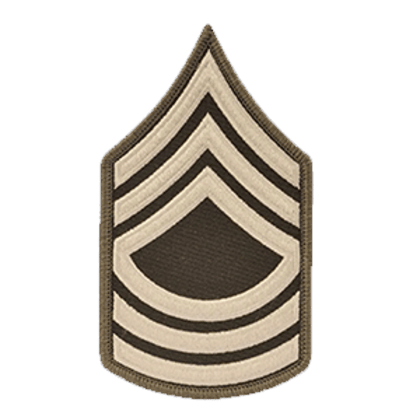 E8 | MSG
E8 | MSGDescription
The rank of Master Sergeant says it all: Master of the art of leadership. The Master Sergeant serves as the principal NCO in staff elements at company and often higher levels. Although not charged with the enormous leadership responsibilities of the First Sergeant, the Master Sergeant is expected to dispatch leadership and other duties with the same professionalism and to achieve the same results as the First Sergeant.
Prerequisites
1) Ten (10) months TIS overall
2) Demonstrated success at all levels of NCO leadership
3) Is an example to be followed in all areas, including Prerequisites of all ranks below E-8
4) Ability to assist the Command Staff where necessary
5) Recommendation from the Officers of Command Staff
-
Sergeant First Class
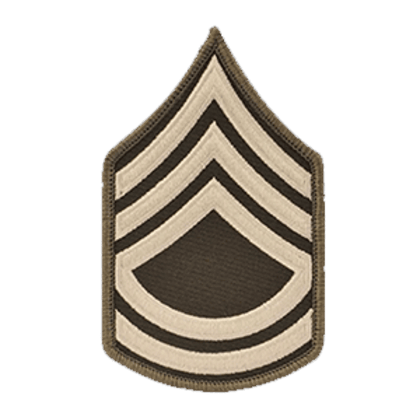 E7 | SFC
E7 | SFCDescription
The Sergeant First Class is the Platoon level NCO. He has proven himself not only an excellent Squad Leader in the past, but also an effective Platoon Sergeant. He has become a force to be reckoned with inside the Company and a trusted advisor and counselor to all junior NCOs and Enlisted soldiers. Sergeants First Class are the very definition of "Senior NCO".
Prerequisites
1) Four (4) months TIG as E-6 Staff Sergeant
2) Demonstrated success as a Platoon Sergeant or equivalent
3) Graduated Advanced Leadership Course
4) Ability to assist the First Sergeant where necessary and maintain a high level of leadership ability
5) Recommendation from Command Staff
-
Staff Sergeant
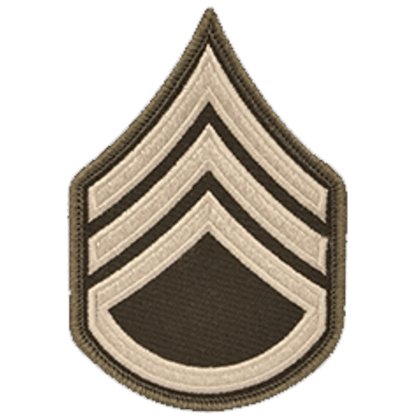 E6 | SSG
E6 | SSGDescription
The Staff Sergeant is a proficient and reliable Squad Leader or senior technical specialist in their field. Their leadership is crucial to the health of the Division. Not only does the Staff Sergeant excel in Squad leadership, they also show the ability to assist the Platoon Sergeant or even serve as one if called upon.
Prerequisites
1) Four (4) months TIG as E-5 Sergeant
2) Demonstrated success as a Squad Leader
3) Shows leadership in all areas and is a positive role model for all soldiers to follow
4) Have Graduated Warrior Leadership School as an E-5 SGT or prior
5) Must attend Advanced Leadership Course within 3 to 6 months after promotion to SSG. Attending ALC as a SGT is always recommended.
6) Ability to assist the Platoon Sergeant where necessary
7) Recommendation Promotion Board and Command Staff
-
Sergeant
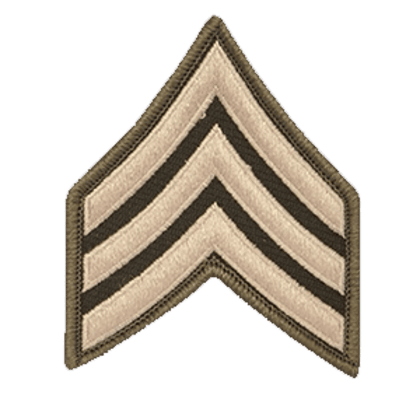 E5 | SGT
E5 | SGTDescription
The rank of Sergeant is the entree to a hallowed fraternity. Sergeants run the Army, and of that there can be no doubt. A Sergeant is a proven leader and can lead a Fireteam or even a Squad if necessary, as well as serve as a technical specialist in their MOS' and also as NCOIC of a DMOS. The Sergeant is where the axe meets the stone.
Prerequisites
1) Two (2) months TIG as E-4A Corporal
2) Selected to attend or graduated Warrior Leadership Course
3) Important part of Squad and DMOS activities
4) Ability to write Squad Reports and turn them in prior to the deadline
5) Ability to conduct Squad training as directed by the Squad Leader
6) Recommendation from Squad Leader and Promotion Board
